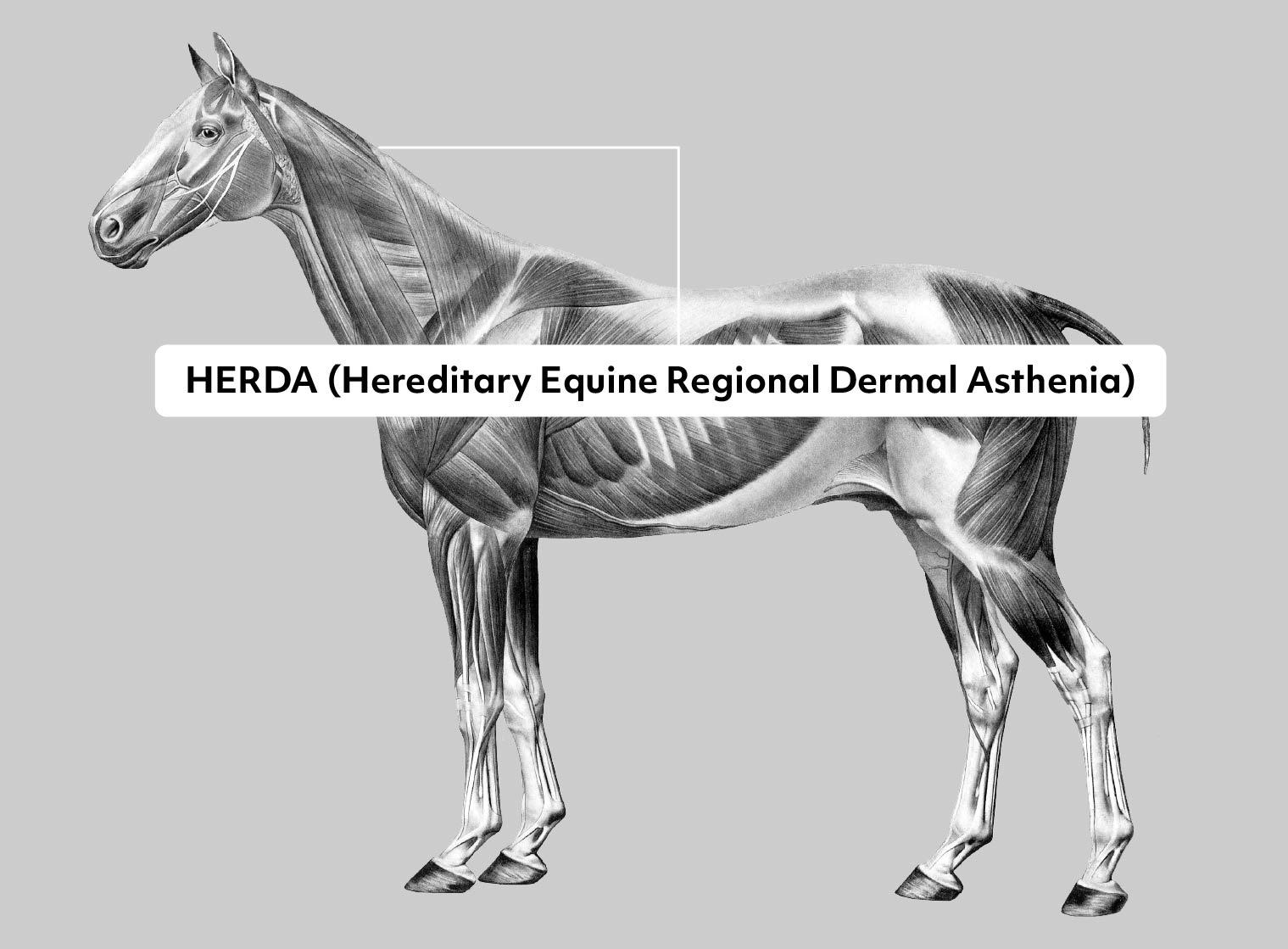Hereditary Equine Regional Dermal Asthenia (HERDA)
Gene or Region: PPIB
Reference Variant: G
Mutant Variant: A
Affected Breeds: Quarter Horse
Research Confidence: High - Findings reproduced in multiple studies
Explanation of Results: herda/herda = homozygous for Hereditary Equine Regional Dermal Asthenia, trait expressed, may result in severe/fatal health issues herda/n = heterozygous for Hereditary Equine Regional Dermal Asthenia, carrier n/n = no variant detected
General Description for Hereditary Equine Regional Dermal Asthenia (HERDA)
Hereditary Equine Regional Dermal Asthenia (HERDA) is a degenerative skin disease that primarily affects the American Quarter Horse breed. Loose skin is often an early indication of the disease, and severe seromas, hematomas, ulcerations usually develop around 1.5 years of age and progressively worsen. There is no cure, and the majority of affected animals have to be euthanized within 2-4 years.
A missense mutation in the equine cyclophilin B (PPIB) was determined to cause a functional defect in this protein, resulting in less effective catalysis of the rate-limiting step in collagen folding. Etalon offers diagnostic testing to determine carrier or affected status.
This disease follows an autosomal recessive mode of inheritance, so in order for the foal to be affected, both the sire and the dam must carry the allele. This also means that horses can appear normal but be carriers for the condition. If two carrier horses mate, there is a 25% chance that the foal will have HERDA. Studies estimate that ~3.5% of Quarter Horses are carriers. It's recommended that both carriers and clinically affected horses with HERDA be removed from breeding programs.
References
Tryon et al., “Homozygosity mapping approach identifies a missense mutation in equine cyclophilin B (PPIB) associated with HERDA in the American Quarter Horse.” (2007) Genomics 90: 93-102. PMID: 17498917
Ishikawa Y, Vranka JA, Boudko SP, Pokidysheva E, Mizuno K, Zientek K, Keene DR, Rashmir-Raven AM, Nagata K, Winand NJ, Bächinger HP. Mutation in cyclophilin B that causes hyperelastosis cutis in American Quarter Horse does not affect peptidylprolyl cis-trans isomerase activity but shows altered cyclophilin B-protein interactions and affects collagen folding. J Biol Chem. 2012 Jun 22;287(26):22253-65. doi: 10.1074/jbc.M111.333336. Epub 2012 May 3. PMID: 22556420; PMCID: PMC3381186.
More Horse Health
"Warmblood" Fragile Foal Syndrome
"Warmblood" fragile foal syndrome (FFS) is a connective tissue disorder resulting in joint laxity and extremely thin skin that is only loosely connected to the body. The skin is easily torn, resulting in lacerations, hematomas, and seromas across the foal. Affected foals are euthanized shortly after birth.
Androgen Insensitivity Syndrome
Androgen Insensitivity Syndrome (AIS) is an X-linked disorder of sexual development resulting in a female horse with XY chromosomes. Horses with AIS exhibit stallion-like behavior such as agression toward other horses, Flehman response and vocalization toward cycling mares.
Cerebellar Abiotrophy
Cerebellar Abiotrophy (CA) is a degenerative neurological disorder, due to the death of neurons in the brain. Symptoms (head tremors, lack of coordination, wide stances, exaggerated gain, difficulty rising and startling easily), typically appear in foals between six weeks and four months of age.
Chronic Idiopathic Anhidrosis Risk
Chronic Idiopathic Anhidrosis Risk (CIA) is the inability to sweat in response to increased body temperature, (AKA "non-sweater"). This condition is dangerous and sometimes life-threatening for horses, who rely on sweating for 65-70% of their temperature regulation.
